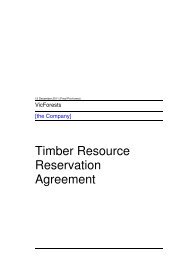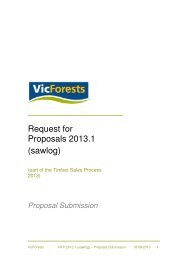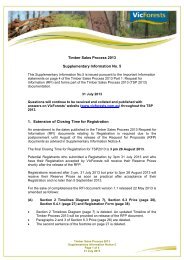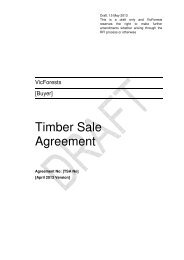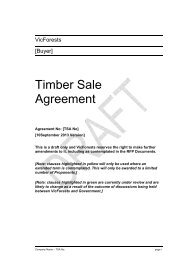Module 5 - VicForests
Module 5 - VicForests
Module 5 - VicForests
You also want an ePaper? Increase the reach of your titles
YUMPU automatically turns print PDFs into web optimized ePapers that Google loves.
FOREST AUDIT PROGRAM, AUDIT WORKBOOK 5F – COUPE INFRASTRUCTURE<br />
Boundary Tracks<br />
Measurement<br />
Measurement Methodology:<br />
Where present, inspect as much boundary track as possible (at least 200 metres) during coupe inspection. Note measured distance of boundary track inspected and<br />
assess that drainage structures are the requirements.<br />
Total Distance of Boundary Track Inspected: ……………m<br />
Required Drainage structure spacing: ……………m<br />
Number of drainage structures inspected: ……………(x)<br />
Number of non-effective drainage structures: ……………(y)<br />
Effective number of drainage structures:<br />
Length of non compliance:<br />
Topsoil SEH: «TopsoilErosion»<br />
Subsoil SEH: «SubsoilErosion»<br />
……………(x-y)<br />
……………m<br />
Maximum Distance between Cross Drains (VF Utilisation Procedures, July 2006, Schedule 1)<br />
SEH < 6 0 or 10% 6-11 0 or 10-20% 11-18 0 or 20-33% 18-27 0 or 33- >27 0 or 50%<br />
Low 120 m 90 60 30 15<br />
Medium 90 60 40 20 10<br />
High 60 30 20 10 Not allowed<br />
Maximum Distance between Drainage Structures (October 2005 Management Procedures)<br />
SEH<br />
1:50<br />
1°<br />
2%<br />
1:25<br />
2°<br />
4%<br />
1:15<br />
3.5°<br />
6%<br />
1:12<br />
4.5°<br />
8%<br />
1:10<br />
6°<br />
10%<br />
1:8<br />
7°<br />
12%<br />
1:7<br />
8°<br />
15%<br />
1:5<br />
11°<br />
20%<br />
Low 250 170 130 115 100 90 60 30<br />
Medium 200 150 120 105 90 80 50 Not perm.<br />
High 160 130 110 95 80 65 Not perm Not perm<br />
n Chain (m) Structure Effective Spacing Slope Comments<br />
1 RO / CD / Cul Y / N<br />
2<br />
3<br />
4<br />
5<br />
6<br />
7<br />
8<br />
9<br />
10<br />
11<br />
12<br />
13<br />
14<br />
15<br />
16<br />
17<br />
18<br />
19<br />
20<br />
21<br />
22<br />
23<br />
24<br />
25<br />
FOREST AUDIT PROGRAM – MODULE 5 HARVESTING AND CLOSURE, APRIL 2010 PAGE 23 OF 24<br />
FOREST AUDIT PROGRAM, AUDIT WORKBOOK 5F – COUPE INFRASTRUCTURE<br />
Forest Audit – Measurement Guide<br />
Environmental Impact Assessment<br />
When considering a code breach relating to the workbook elements, the<br />
impact of the breach on the environment must be assessed using the<br />
environmental impact assessment method as a guide. The impact<br />
assessment is to be based on the non-compliance observed at the time of<br />
audit and must be conducted in consultation with a forest officer.<br />
The environmental impact assessment is based on the following factors:<br />
o Extent of Impact or Disturbance within sample (E)<br />
• The extent of the impact, measure as a relative percentage of the<br />
sampled area or length. Defined into 4 categories.<br />
• 0 – 10%<br />
• 11 – 25%<br />
• 26 – 50%<br />
• >50%<br />
• A fifth category is used when the impact or disturbance results in an<br />
offsite effect, that is an area outside of the coupe boundary is<br />
affected.<br />
o Duration of impact or expected time to recover (t)<br />
• The duration of the impact is defined as the period in which the area<br />
will recover to pre-impacted levels. The impact period is defined by<br />
three levels,<br />
• Short Term 0 – 12 months<br />
• Medium Term 12 – 36 months<br />
• Long Term > 3 years<br />
o Environmental Asset Value (z)<br />
• The environmental asset value of the impacted area is defined by<br />
the relative resilience and resistance of the area affected, and the<br />
value of the area as defined by is protection endorsed within the<br />
Code of Forest Practice. The environmental asset value is divided<br />
into four categories;<br />
• General environmental value<br />
• Filter or drainage line<br />
• Representative SPZ, i.e. habitat corridors, landscape buffers<br />
and some linear buffers.<br />
• Specific SPZ, i.e. for specific flora and fauna, rainforest buffers<br />
and riparian or streamside reserve buffers.<br />
Environmental Impact Assessment Rating<br />
Duration of Impact (t)<br />
Extent (E) Short Term Medium Term Long Term<br />
0 - 10% A C F<br />
11 - 25% B E H<br />
26 - 50% C F I<br />
> 50% D G J<br />
offsite E H K<br />
Environmental Asset Value (z)<br />
Et Value General Filter rSPZ / LR / LB sSPZ / RB / RF<br />
A Negligible Negligible Minor Minor<br />
B Negligible Minor Moderate Moderate<br />
C Negligible Minor Moderate Moderate<br />
D Negligible Moderate Moderate Moderate<br />
E Minor Moderate Moderate Major<br />
F Minor Moderate Major Major<br />
G Moderate Moderate Major Major<br />
H Moderate Major Major Major<br />
I Moderate Major Major Severe<br />
J Moderate Major Severe Severe<br />
K Major Major Severe Severe<br />
FOREST AUDIT PROGRAM – MODULE 5 HARVESTING AND CLOSURE, APRIL 2010 PAGE 24 OF 24




